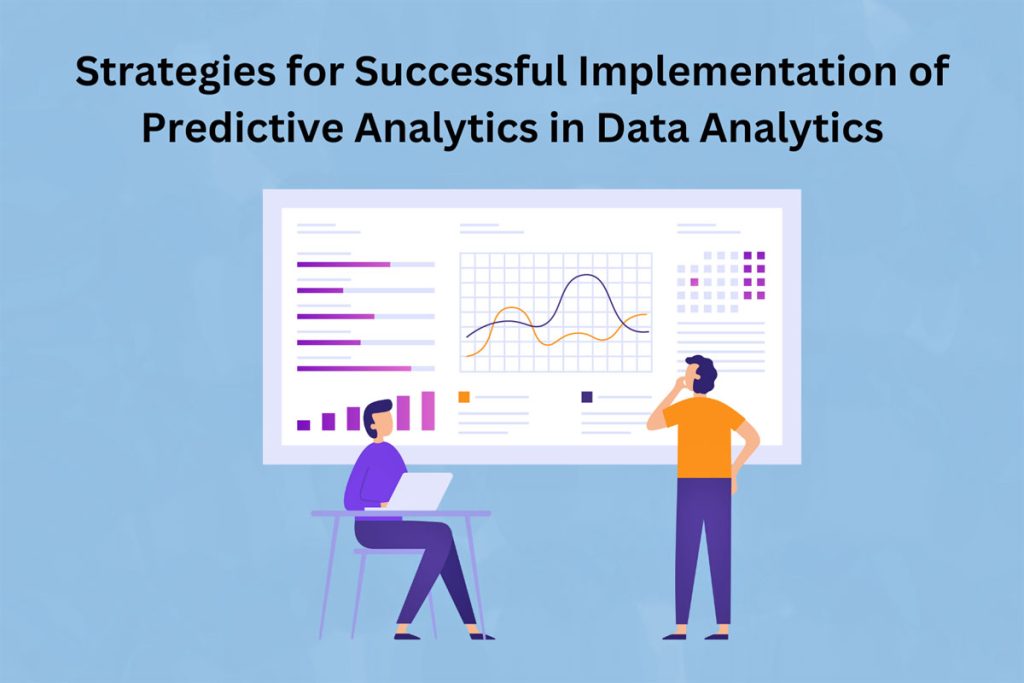The organizations increasingly understand the value of data to benefit insights, make knowledgeable selections, and force strategic projects. Predictive analytics, a subset of statistics analytics, holds incredible promise for organizations that want to use their data successfully. Predictive analytics helps companies optimize methods, reduce risks, and foresee patron behavior via predicting patterns and effects. A Data Analytics Course helps professionals understand the Importance of Data Analytics, such as Predictive analytics and forecasting. This blog will discuss some essential strategies for using predictive analytics in data analytics.
Table Of Contents
- Define Clear Objectives and Use Cases
- Assess Data Readiness and Quality
- Invest in Data Infrastructure and Technology
- Develop Analytical Capabilities and Talent
- Iterate and Refine Predictive Models
- Foster Cross-Functional Collaboration
- Monitor Performance and Measure Impact
- Conclusion
Define Clear Objectives and Use Cases
The preliminary level in deploying predictive analytics is to establish properly-defined desires and use cases that align with the employer’s ordinary strategic goals. Determine whether troubles or possibilities for your company should gain from using predictive analytics, such as turnover prediction, call for forecasting, customer segmentation, or fraud detection. Allocating resources wisely, prioritizing tasks, and ensuring predictive analytics projects provide demonstrable results are made possible when organizations concentrate on concrete business outcomes.
Assess Data Readiness and Quality
Good predictive analytics depends on data that is of good quality. Businesses should evaluate the state of their data assets and readiness for predictive analytics projects before launching such projects. After a thorough data audit, you should take measures to clean, normalize, and enhance the data to fix any problems, such as gaps, inconsistencies, or biases. Set up data governance procedures and standards to guarantee data security, consistency, and integrity across analytics lifetime.
Invest in Data Infrastructure and Technology
To successfully apply predictive analytics, investing in data infrastructure and technology is vital. A robust data infrastructure and the correct technology are prerequisites. Implement your money into data platforms that can grow with your business and adapt to different data formats, volumes, and sources. Select analytics technologies, tools, and libraries—like data visualization platforms, statistical programmers, and machine learning libraries—that work well with predictive modelling. Please consider cloud-based solutions for their scalability, affordability, and deployment ease. Ensure they integrate with your current systems and workflows, so data administration and analysis go smoothly.
Develop Analytical Capabilities and Talent
A data science, statistics, and machine learning expert staff are essential for effectively deploying predictive analytics. Educate and teach your team to make the most of predictive analytics by investing in training and development programmers to build analytical capabilities. Promote an environment where data drive decisions and innovations and business and analytics teams work together to turn insights into strategies and results.
Iterate and Refine Predictive Models
To get the most out of predictive analytics, an iterative process, you need to improve your models constantly. Iteratively incorporate new data, refine algorithms, and test hypotheses to increase accuracy and performance; start with simple models.
Improve the accuracy and generalizability of your predictive models by using tools like ensemble modelling, feature engineering, and cross-validation. To make certain that predictive analytics initiatives provide honest and treasured insights, keep an eye on how the models are doing and compare the effects to the actual global.
Foster Cross-Functional Collaboration
Various stakeholders and departments inside an enterprise need to work collectively for predictive analytics to be successfully applied. The success of predictive analytics projects depends at the close cooperation of several departments, inclusive of business gadgets, information technology (IT) teams, statistics scientists, and domain professionals.
Involving stakeholders and give up-users in predictive model layout, development, and validation increases adoption, acceptance and value realization. Open traces of communication and well-described governance frameworks promote responsibility, transparency, and collaboration in the analytics lifecycle.
Monitor Performance and Measure Impact
Tracking the progress of predictive analytics projects and evaluating their effects is essential to determine their efficacy and worth. Accuracy, precision, recall, return on investment (ROI), and business effect are some KPIs and metrics that should be defined for the company’s goals.
Check on key performance indicators, see styles, and percentage your findings with the right humans the use of data visualization and reporting tools. To get the maximum out of your predictive analytics efforts, you must usually look at the return on investment (ROI) and make any essential modifications for your strategy or investments.
Check more:
- Understanding Analytical Exposition Text and Examples
- Example of a Good and Polite Resignation Letter
Conclusion
It takes a well-thought-out strategy, meticulous preparation, and flawless execution to adopt predictive analytics successfully. Organizations can achieve business success using predictive analytics if they follow these steps: establish clear objectives and use cases, evaluate data readiness and quality, invest in data infrastructure and technology, build analytical capabilities and talent, refine and iterate predictive models, encourage cross-functional collaboration, monitor performance and measure impact.
Organizations can achieve sustainable development, new opportunities, and a competitive edge by using predictive analytics to optimize operations, anticipate customer behavior, and minimize risks.
